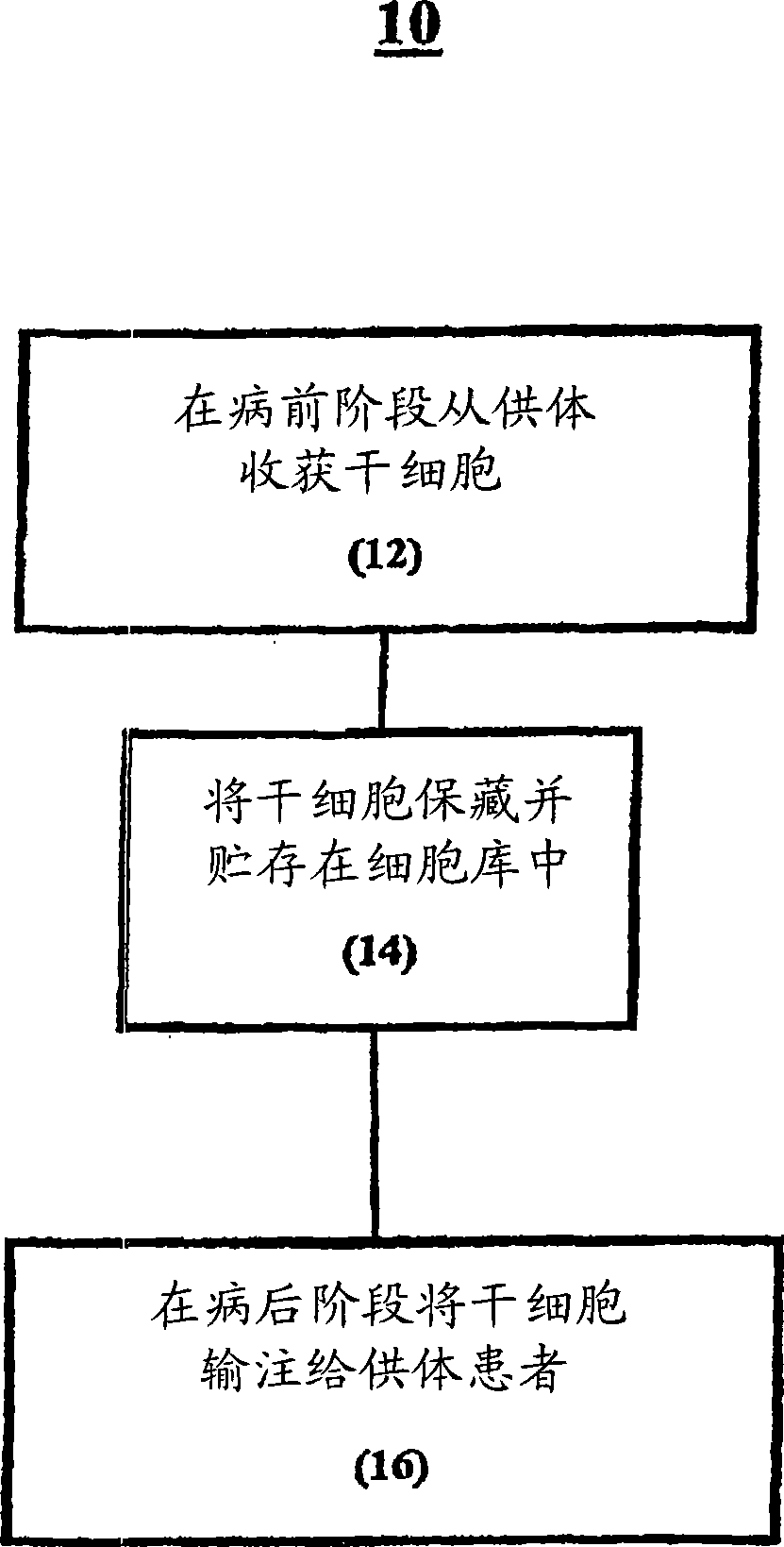Processing procedure for peripheral blood stem cells
A stem cell, peripheral blood technology, applied in blood/immune system cells, animal cells, vertebrate cells, etc.
- Summary
- Abstract
- Description
- Claims
- Application Information
AI Technical Summary
Problems solved by technology
Method used
Image
Examples
Embodiment approach
[0067] refer to figure 1 , step 10 of the present invention in combination with an embodiment of the present invention generally includes the following steps:
[0068] (1) Healthy stem cells are collected while the individual is in the "pre-disease" stage (12). By "pre-disease" is meant that the individual is healthy, or that the individual develops, manifests, or is diagnosed with any or a specific disease that is known to affect the quality of stem cells, or that the individual Said individual is considered to be in a certain health condition, so that it cannot collect stem cells of a certain quality.
[0069] (2) The cells in the pre-disease state are preserved and stored in a stem cell bank (14), eg, by freezing, for many years, eg, 500 years or less. Preferably, the cells in the pre-disease state are preserved and maintained in a stem cell bank throughout the life of the individual, after which time the cells may be discarded or used for allogeneic transplantation or ot...
Embodiment approach
[0161] Therefore, an embodiment provided by this invention: when the non-neonatal or adult is in the pre-disease stage, the stem cells of the non-neonatal or adult are collected and stored (for example: cryopreservation), and the method of collecting stem cells can be used Plasmapheresis is achieved. Injection of growth factors, such as G-CSF, is required 1-6 days before harvesting the stem cells. According to a preferred embodiment: non-newborns or adults are given cell growth factors for two consecutive days, and peripheral blood stem cells are separated by plasmapheresis on the third day. In order to store the collected stem cells for future use, freezing techniques and cryogens can be applied.
[0162] Later (for example, years later) once the person with preserved stem cells develops cancer, immune disease, infectious disease, heart disease, helix disease, pancreas disease, liver disease, or bone marrow disease or encounters a condition that causes immunosuppression due ...
Embodiment 1
[0242] Example 1: Collection and cryopreservation of peripheral blood stem cells
[0243] A patient whose stem cells are to be preserved for future autologous transfer is selected, and peripheral blood stem cells from that patient are collected. Briefly, the patient's vital medical parameters were collected, including age (45 years), weight (150 lbs), sex (male), blood pressure (120 / 80) and hematocrit value (42%). The total blood volume of the donor was calculated from the sex, height and weight of the donor, and the process volume of total blood per cycle was determined from the hematocrit value. The centrifugal speed of the blood separator was set at 4800rpm, and the critical flow rate was set at 50ml / min.
[0244] The patient's stem cells were collected for 3 hours. The total volume of cells collected was 250ml. These cells were washed with sterile RPMI medium and resuspended in cryopreservation medium (RPMI+10% glycerol+5% DMSO). Half of the cells were aliquoted into 2...
PUM
| Property | Measurement | Unit |
|---|---|---|
| Weight | aaaaa | aaaaa |
Abstract
Description
Claims
Application Information
 Login to View More
Login to View More - R&D
- Intellectual Property
- Life Sciences
- Materials
- Tech Scout
- Unparalleled Data Quality
- Higher Quality Content
- 60% Fewer Hallucinations
Browse by: Latest US Patents, China's latest patents, Technical Efficacy Thesaurus, Application Domain, Technology Topic, Popular Technical Reports.
© 2025 PatSnap. All rights reserved.Legal|Privacy policy|Modern Slavery Act Transparency Statement|Sitemap|About US| Contact US: help@patsnap.com



